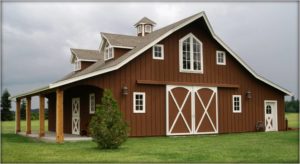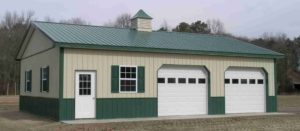Shed or Barn
 A bare acreage of land has been bought. The tractor and 4-wheeler won at an auction last month are moved into a 10 X 12 meter ( 30′ X 40′ ) storage-shed. The shed framed inside with a small windowed room with an exit door. This will work nicely as a place for your first collection of farm equipment and a place to bed down on your weekend visits.
A bare acreage of land has been bought. The tractor and 4-wheeler won at an auction last month are moved into a 10 X 12 meter ( 30′ X 40′ ) storage-shed. The shed framed inside with a small windowed room with an exit door. This will work nicely as a place for your first collection of farm equipment and a place to bed down on your weekend visits.
But, hang on, you invite your friends out for a look-see, and in the evening, they open the roll-up doors and relax, maybe with a fire pit or a barbecue lit to feed the hungry visitors. Later, the family comes out to see the progress. It seems you need a little more space for people to sleep-over night and a kitchen would come in really handy. You’ll need a shower room, so plumbing needs to be arranged. It’s best to get that toilet plumbed and installed at the same time, another separate room will need to be built for that. Space is constantly being reallocated as needs are being identified. What once was a shed with a cot in the corner has now become a barndominium, much larger, nicer and even permanent than was first imagined. In fact, it’s so nice now that it’s become the home, no need to build a traditional house.
Sheddominions and Barndominions are Gaining in Popularity, but are they legal?
 Are you legally able to live in a shed or barn? This is the number one question; a highly argumentative and sensitive subject. The answer is yes, and no. If you live in an unmodified shed or barn, then the answer is generally no. But, if your structure meets certain building code conditions for habitation, then the answer may be yes.
Are you legally able to live in a shed or barn? This is the number one question; a highly argumentative and sensitive subject. The answer is yes, and no. If you live in an unmodified shed or barn, then the answer is generally no. But, if your structure meets certain building code conditions for habitation, then the answer may be yes.
You will need to talk with your local council. You will need approval from the council in order to use a shed as a temporary dwelling and you will often need to have a Development Application approved for a future home (so the council can see that the shed is not the only building intended for the property).
What Your Shed Needs to Be Liveable
If you’re planning on living in a shed or barn and you’ve received the necessary approvals, there are some basic standards that will need to be meet. The shed or barn will need to be built to code so that it is habitable. The structure will need to meet some basic standards, such as vapor barriers in the concrete slab and wall cavities, ceiling heights will also need to be complied with, insulation to a minimum ‘R’ rating, include efficient hot water, good ventilation, power, wall and floor coverings, appropriate doors and windows, etc. The waste will need to be connected to a sewer line or septic tank and wastewater to an appropriate greywater system – everything that you would expect of a standard modern home.
